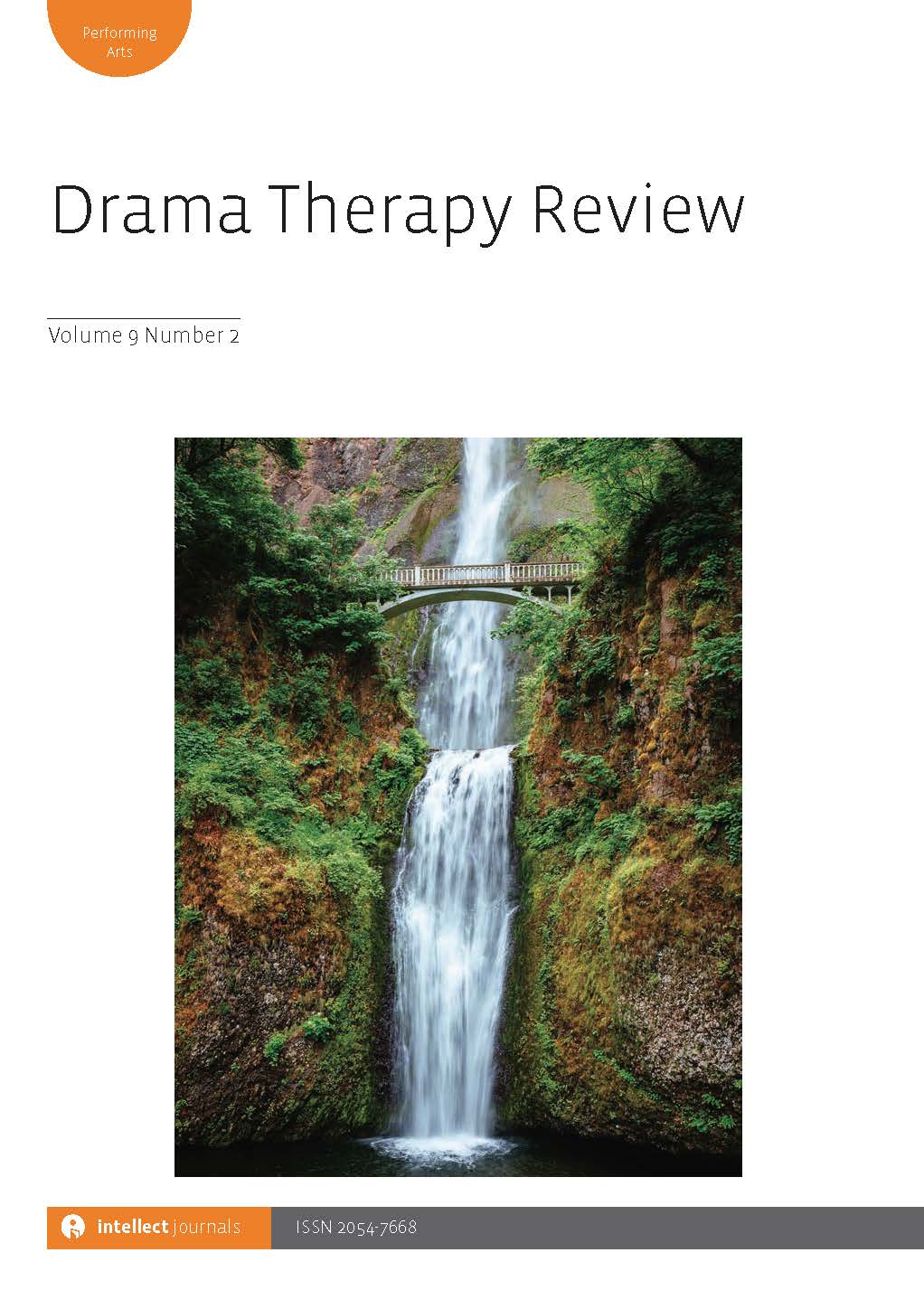-
oa A scoping review of observed benefits of Developmental Transformations (DvT)
- Source: Drama Therapy Review, Volume 9, Issue 2, Oct 2023, p. 273 - 315
-
- 01 Feb 2023
- 15 Jul 2023
- 05 Oct 2023
Abstract
Developmental Transformations (DvT), a practice involving interactive, improvisational play in pairs or groups, has gained international appeal as a therapeutic intervention for different populations in a variety of health, care and recreational contexts. However, a rigorous review of the benefits of DvT has not been conducted. The purpose of this study was to review extant literature for the observed benefits of DvT, identify gaps in the literature and make recommendations concerning future research including identifying possible areas for outcome measurement for preliminary studies. The authors, who each completed training in this approach, conducted a scoping review of English-language, published, peer-reviewed and grey DvT literature through 2021. From an initial 745 records retrieved through databases and a manual search, 51 publications met criteria, which, when analysed using in-vivo and pattern coding, resulted in a total of seventeen categories of observed benefits ascribed to DvT. These included six general categories – relational, emotional, social, cognitive, behavioural and physical benefits – and eleven complex categories of benefits to participants across the lifespan. In addition to benefits for participants, benefits of DvT were also observed and reported for facilitators, therapists, teachers and supervisors engaged in this practice. This review revealed inconsistencies regarding the reporting of practitioner training, frequency, format, population, intended goals, assessment measures and outcomes. Future studies with increased experimental rigor, standardized outcome measures and consistent reporting are recommended.
ResumenLas Transformaciones del Desarrollo (DvT), una práctica que involucra juegos interactivos e improvisados en parejas o grupos, han ganado atractivo internacional como una intervención terapéutica para diferentes poblaciones en una variedad de contextos de salud, cuidado y recreación. Sin embargo, no se ha realizado una revisión rigurosa de los beneficios de la aplicación de la DvT. El propósito de este estudio fue revisar la literatura existente sobre los beneficios observados de la DvT, identificar las lagunas presentes en la literatura y hacer recomendaciones para las investigaciones futuras, incluyendo la identificación de posibles áreas para la medición de resultados para estudios preliminares. Los autores, cada uno de los cuales completó la capacitación en este enfoque, realizaron una revisión de alcance, de la literatura gris y revisada por pares, publicada sobre la DvT, en inglés hasta 2021. De los 745 registros iniciales recuperados a través de bases de datos y una búsqueda manual, 51 publicaciones cumplieron con los criterios que, cuando se analizó mediante codificación in vivo y de patrones, dio como resultado un total de 17 categorías de beneficios observados atribuidos a la DvT. Estos incluían seis categorías generales: beneficios relacionales, emocionales, sociales, cognitivos, conductuales y físicos; y 11 categorías complejas de beneficios para los participantes a lo largo de la vida. Además de los beneficios para los participantes, también se observaron e informaron los beneficios de la DvT en los facilitadores, terapeutas, maestros y supervisores involucrados en esta práctica. Esta revisión reveló inconsistencias con respecto al informe de la capacitación de los profesionales, la frecuencia, el formato, la población, las metas previstas, las medidas de evaluación y los resultados. Se recomiendan estudios futuros con mayor rigor experimental, medidas de resultado estandarizadas e informes consistentes.
RésuméLes transformations développementales (DvT) – une pratique impliquant un jeu interactif et improvisé en paires ou en groupes – ont acquis un attrait international en tant qu’intervention thérapeutique pour différentes populations dans une variété de contextes de santé, de soins et de loisirs. Cependant, on n’a pas effectué d’examen rigoureux des avantages des DvT. Le but de cette étude était d’examiner les avantages observés des DvT, d’identifier les lacunes dans la littérature à ce sujet, et de faire des recommandations concernant les recherches futures, y compris l’identification des domaines possibles de mesure des résultats pour les études préliminaires. Les auteurs, qui ont chacun suivi une formation sur cette approche, ont examiné la portée de la littérature DvT en anglais, publiée, évaluée par des pairs et grise jusqu’en 2021. Sur les 745 premiers enregistrements récupérés via des bases de données et une recherche manuelle, 51 publications répondaient aux critères qui, lorsqu’ils ont été analysés à l’aide d’un codage in vivo et de modèles, ont abouti à un total de 17 catégories d’avantages observés attribués aux DvT. Celles-ci comprenaient six catégories générales: avantages relationnels, émotionnels, sociaux, cognitifs, comportementaux et physiques, ainsi que 11 catégories complexes d’avantages pour les participants tout au long de la vie. Les avantages des DvT ont été observés et signalés par des animateurs, des thérapeutes, des enseignants et des superviseurs engagés dans cette pratique. Cet examen a, en outre, révélé des incohérences concernant les rapports sur la formation des praticiens, la fréquence, le format, la population, les objectifs visés, les mesures d’évaluation et les résultats. On recommande que de futures études soient menées avec une rigueur expérimentale accrue, des mesures de résultats standardisées, et des rapports cohérents.
Funding
- NYU Steinhardt Theatre and Health Lab in the NYU Program



